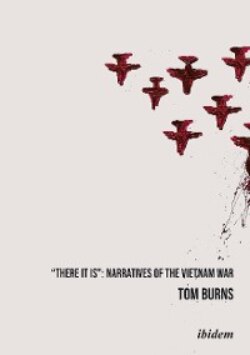Читать книгу "There It Is": Narratives of the Vietnam War - Tom Burns - Страница 3
ОглавлениеTable of Contents
Acknowledgments
Introduction
i. The Vietnam War
ii. The Soldiers
iii. The Narrative Literature of the War
iv. The Present Study
Part I Partisans
Chapter One Early Adventurers
i. Lieutenant-Colonel Landsdale
ii. Graham Greene, The Quiet American (1955)
iii. William J. Lederer & Eugene Burdick, The Ugly American (1958)
iv. M. J. Bosse, The Journey of Tao Kim Nam (1959)
v. Jean Lartéguy, Yellow Fever (1962; English Translation, 1965)
vi. Epilogue: Ward Just, A Dangerous Friend (1999)
Chapter Two Fictional History & Historical Fiction: The Fall of Diem
i. President Ngo Dinh Diem
ii. Stuart Hempstone, A Tract of Time (1966)
iii. Robert Vaughn, The Valkyrie Mandate (1974)
iv. Morris West, The Ambassador (1965)
v. Conclusions
Chapter Three Advisors & Friendlies: Pro-War Novels
i. Optimism in the early phases
ii. Robin Moore, The Green Berets (1965)
iii. Scott C. S. Stone, The Coasts of War (1966)
iv. Richard Newhafer, No More Bugles in the Sky (1966)
v. Gene D. Moore’s The Killing at Ngo Tho (1967)
vi. James Crumley, One to Count Cadence (1969)
vii. Charles Larson, The Chinese Game (1969)
vii. Conclusions
Chapter Four Advisors & Friendlies II: Ambivalent Warriors
i. Doubt sets in
ii. David Halberstam, One Very Hot Day (1967)
iii. Daniel Ford, Incident at Muc Wa (1968)
iv. John Rowe, Count Your Dead (1968),
v. Alan Clark, The Lion Heart: a Tale of the War in Vietnam (1969)
vi. Josiah Bunting, The Lionheads (1972)
vii. Bo Hathaway’s A World of Hurt (1981),
viii. Donald McQuinn, Targets (1980)
ix. Conclusions
Chapter Five Soldiers & Civilians
i. Protestors & Reporters
ii. Norman Mailer, Armies of the Night (1968)
iii. Pamela Sanders, Miranda (1978)
iv. Thomas Fleming’s The Officers’ Wives (1981)
v. Joan Didion, Democracy (1984)
vi. Takeshi Kaiko’s Into a Black Sun: Vietnam 1964–65 (1968, English trans. 1983)
vii. Bernard Kalb and Martin Kalb, The Last Ambassador (1981)
viii. Conclusions
Part II Modes and Genres
Chapter Six Combat Memoirs
i. Autobiographical War Writings
ii. Ron Kovic, Born on the Fourth of July (1976)
iii. Philip Caputo, A Rumor of War (1977)
iv. Tim O’Brien, If I Die in a Combat Zone, Box Me Up and Ship Me Home (1975)
v. Frederick Downs, The Killing Zone (1978)
vi. W.D. Ehrhart, Vietnam-Perkasie—A Combat Marine’s Memoir (1983)
vii. Robert Mason, Chickenhawk (1983)
viii. Tobias Wolff, In Pharoah’s Army—Memoirs of the Last War (1994)
ix. Conclusions
Chapter Seven Allegory
i. Allegorical Vietnam
ii. Jonathan Rubin, The Barking Deer (1974)
iii. Asa Baber, The Land of a Million Elephants (1971)
iv. Victor Kolpakoff, The Prisoners of Quai Dong (1967)
v. Norman Mailer, Why Are in Vietnam? (1967)
vi. Robert Stone, Dog Soldiers (1974)
vii. Joe Haldeman, The Forever War (1975)
viii. Conclusions
Chapter Eight Combat Realism
i. Conventions of Realism
ii. Robert Roth, Sand in the Wind (1973)
iii. Stephen Philip Smith, American Boys (1975)
iv. Tom Suddick, A Few Good Men (1974)
v. William Pelfrey, The Big V (1972)
vi. William Turner Huggett, Body Count (1973)
vii. Larry Heinemann, Close Quarters (1974)
viii. Conclusion
Chapter Nine Combat VS. Ideology
i. Two Authors
ii. James Webb, Fields of Fire (1978)
iii. John Del Vecchio, The 13th Valley (1983)
iv. Comparisons & Conclusions
v. Epilogue: Karl Marlantes, Matterhorn: A Novel of the Vietnam War (2010)
Chapter Ten Deviations
i. Alternatives to Realism
ii. William Wilson, The LBJ Brigade (1966)
iii. James Park Sloan, War Games (1971)
iv. John Clark Pratt, The Laotian Fragments (1974) & Vietnam Voices (1984)
v. Ward Just, Stringer (1984)
vi. Lloyd Little, Parthian Shot (1975)
vii. Gustav Hasford, The Short-Timers (1979)
viii. Conclusion
Chapter Eleven Inventions: Fantasy & Metafiction
i. Literature of the Optative Mode
ii. William Eastlake, The Bamboo Bed (1969)
iii. Tim O’Brien, Going After Cacciato (1975)
iv. Nicholas Rinaldi, Bridge Fall Down (1985)
v. Tim O’Brien, The Things They Carried
vi. Conclusions
Chapter Twelve Correspondents
i. Reporters in the Nam
ii. Library of America collection: Reporting Vietnam (1998)
iii. John Sack, M (1966)
iv. Harrison E. Salisbury, Behind the Lines—Hanoi (1967)
v. Jonathan Schell, The Village of Ben Suc (1967) & The Military Half (1968)
vi. Gloria Emerson, Winners and Losers (1976)
vii Mary McCarthy, Vietnam (1967) and Hanoi (1968)
viii. James Jones’ Viet Journal (1973)
ix. Michael Herr, Dispatches (1968)
x. Conclusions
Chapter Thirteen Ordinary People: Oral Memoirs
i. War Stories & Oral History
ii. Al Santoli, Everything We Had: an Oral History of the Vietnam War by Thirty-Three Soldiers Who Fought It (1981)
iii. Mark Baker, Nam—The Vietnam War in the Words of the Men and Women Who Fought There (1987)
iv. Keith Walker, A Piece of My Heart: The Stories of Twenty-Six American Women Who Served in Vietnam (1985)
v. Wallace Terry, Bloods: An Oral History of the Vietnam War by Black Veterans (1984)
vi. Conclusion
Chapter Fourteen Vets: The Return of the Repressed
i. A.R. Flowers, De Mojo Blues (1985)
ii. Jack Fuller, Fragments (1984)
iii. Bobbie Ann Mason, In Country (1985)
iv. Larry Heineman, Paco’s Story (1986)
v. Stephen Wright, Meditations in Green (1983)
vi. Michael H. Cooper, Dues: a Novel of War and After (1994)
vii. Tim O’Brien’s In the Lake of the Woods (1994)
viii. Conclusion
Bibliography
Primary Works
Secondary Works
